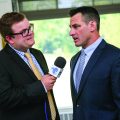Professor Rhonda Quinn played a key role on a team of scientists who discovered the world’s oldest stone tools in Kenya. Their research could upend our ideas about human evolution.
Rhonda Quinn doesn’t mind being wrong. In fact, she welcomes the sudden quake of a discovery that challenges what she knows and has been teaching her Seton Hall students.
“I have always been of the mindset that when you are shown to be wrong, you have actually learned something,” the assistant professor of anthropology says. “That is when you go, ‘Wow! I have to change my thinking. I have to move outside of the box. I have to be creative.’ ”
So when a team of paleoanthropologists determined that primitive stone tools found scattered in a dry riverbed near Lake Turkana in Kenya were around 3.3 million years old — pushing back the clock of what is known about humanity’s first use of tools some 700,000 years — she was thrilled. And when a find is, like this one, a once-in-a-generation discovery that rewrites the textbooks, she says “How fun is that?”
Quinn was at home with her 3-month-old son in 2011 when her colleagues discovered the tools — sharp flakes and blades that had been sheared from larger rocks in a process called knapping — at a site designated as Lomekwi 3. But her contribution to the research, which was published as the cover article in the May 21, 2015, issue of the prestigious journal Nature, was enormously significant. Working with soil samples in her lab at Seton Hall, Quinn used the process of stable isotope analysis to, as she describes it, “sort out the chemical fingerprints or chemical signatures of past soils.”
The goal of her work is to decipher the environment that existed at the time our ancient ancestors lived and evolved. In this case, that meant figuring out what the vegetation of Lake Turkana looked like nearly three-quarters of a million years before the emergence of our large-brained forebears, the genus Homo.
The answer? The earlier hominins that created the Lomekwi tools lived in a woodland environment, not the grassy savannah that has long been thought to be where tool-making began to evolve.
Evidence shows that the ecosystem that existed when the Lomekwi tools were made had not changed for more than a half-million years, Quinn notes. This knowledge undercuts theories that environmental change and shifts in food sources provoked the first making of tools.
“There was no big change,” she says. The emergence of tool-making technology at Lomekwi “was not coincident with any huge shift in environment.”
Quinn’s work to establish the context in which the tools were made, in combination with that of the scientists in the field, is “a milestone in persuading the skeptics and others that the story of tool-making and tool-using in the human story is really much older than people have given credence to,” says the paleoanthropologist Richard Leakey, founder of the Turkana Basin Institute. “It is clear that what Rhonda and other scientists like her have produced adds immeasurably to the richness of the matrix in which these artifacts are discovered.”
As a scientist and teacher, Quinn’s objective is building confidence in her students, both in the field and in the classroom.
Quinn, who joined the Seton Hall faculty in 2011, also serves as director of the University’s Museum of Anthropology and Archaeology. Earlier this year she received a five-year, $450,000 National Science Foundation (NSF) Faculty Early Career Development Program grant to engage undergraduate students in research through assistantships and summer courses and, for area high-school students, laboratory research projects.
In her lab, the students learn how to use stable isotope analysis to generate original data from samples collected from Quinn’s fieldwork around the world.
“My hope,” she says, “is that these lab-based activities will inspire beginning researchers to define and solve their own anthropological questions while honing their skills in [scientific] methods.”
Maria Barca, a junior, has been sharpening her skills while helping Quinn on several projects, and is now an assistant in Quinn’s lab under the NSF grant. “My time spent in the lab forces me to think outside of the box, to question everything and to think critically at all times,” Barca says.
Quinn feels “lucky to be involved in so many anthropological projects” in the field that in turn can enrich the experience of students like Barca. It is, she says, “rewarding to have the chance to mentor aspiring researchers and provide them with the tools necessary for them to succeed.”
David Greenwald is a writer based in Los Angeles.






